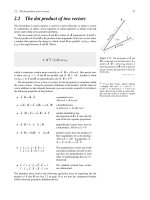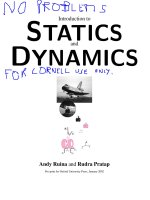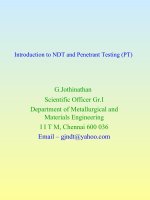Introduction to NDT and penetrant testing
Bạn đang xem bản rút gọn của tài liệu. Xem và tải ngay bản đầy đủ của tài liệu tại đây (269.99 KB, 36 trang )
Introduction to NDT and Penetrant Testing (PT)
G.Jothinathan
Scientific Officer Gr.I
Department of Metallurgical and
Materials Engineering
I I T M, Chennai 600 036
Email –
Introduction To NDT
Non Destructive Testing (NDT) is a
noninvasive method and the testing is carried
out without impairing further usefulness of
the material, component and structure
The component can be put into use after the
Testing. The signals that are employed do not
alter the properties permanently .
Method Signal Remarks
UT US waves - elastic waves Elastic deformation
RT X-rays and gamma rays No damage during
the course of testing
Radiation damage!!!
MT Magnetic field Remnent field-
Demagnetisation
- interesting and highly paying field
- interdisciplinary of metallurgy, physics and
chemistry
NDT accounts for 1/3 of the cost of an
aircraft
(without raw material and fabrication
cost !!)
Definition of terms
NDT
NDI
Used interchangeably- detection and
reporting
NDE
The scope is broader –serviceability is
ascertained
Also includes material characterisation
Material anomalies-interruption ,break,disruption
Discontinuity- can meet the service requirements
Defect/flaw - renders unsuitable for service
Anamoly whether Discontinuity or defect/flaw
1.Nature of the imperfection –linear-volumetric
2.Material –structural or high strength
3.Criticality of use – storage vessel or boiler
boiler in thermal power plant
boiler in nuclear power plant
Linear -crack – length > 3 times width
Volumetric - porosity and inclusion
Applications of NDT
The main application of NDT is
flaw detection and evaluation.
It is also used for
geometric dimension measurement.
material characterization,
bond integrity testing ,
condition monitoring etc
Material characterisation:
1. E and μ determination
2. Grain size evaluation
3. Proportion of microstructural phases
4. Extent of deformation
5. Nodularity of nodular cast iron etc
6. Fracture toughness determination
Purpose of NDT
Fracture mechanics approach – damage
tolerance approach (propagates the idea of
“live with discontinuities”)
A material property, fracture toughness (K
Ic
)
is defined and this characterizes the material
behaviour in presence of discontinuities
which the earlier strength of materials design
approach has not taken into account.
KIc can be experimentally determined.
The stress intensity factor (K
I
) the stress
distribution around a discontinuity
is given by K
I
= G σ √πa where G is
geometric constant, σ is the working stress
and ’ a’ is flaw size.
Failure occurs when K
I
is equal to or greater
than K
Ic
To determine K
I,,
flaw size information
needed and is provided by NDT personnel.
Life extension and life predication methods
also require information on the flaw size.
APPLIED
STRESS
YIELD TENSILE
STRENGTH
(a) The Strength of materials approach
APPLIED
STRESS
FLAW
SIZE
FRACTURE
TOUGHNESS
(b) The Fracture Mechanics approach
Comparison of classical design philosophy with fracture mechanics approach
NDT methods
1.Visual testing (VT)
2.Liquid Penetrant Testing (PT)
3.Magnetic particle Testing (MT)
4.Radiographic Testing (RT)
5.Ultrasonic Testing (UT)
6.Eddy Current Testing (ET) - highly sensitive
7.Acoustic Emission Testing (AET) monitors
activity
8.Thermal Infrared imaging (TIFR)
9.Leak testing (LT)
Surface NDT
Surface &internal
Visual Testing (VT)
This ancient and original method of
examination by human eyes is still widely
employed to find gross discontinuities,
surface irregularities, roughness and
corrosion products on the surface.
Many gadgets like lenses, cameras are used.
For surfaces inaccessible to the human eyes
as in the case of inside surfaces of pipes and
boilers, boroscopes and flexible fibroscopes
are employed. These are called endoscopes
(internal vision). They are nothing but lens
arrangement to transfer the image or the
optical fibers arrangement for transferring
the
image.
VT of welds(contd)
•
Mainly for noncritical welds
•
Before, during and after welding
•
Before -Surface roughness and
cleanliness (oil)
•
During - Electrode size and welders
performance
•
After -Dimensional accuracy of
weldments Conformity of welds to
size and contour requirements
VT of welds (contd)
•
Acceptability of weld appearance
with regard to:
•
Presence of surface discontinuities
such as:
•
surface roughness weld
spatter
•
cleanliness underfill pores
•
Undercuts overlaps
•
Cracks spatter
•
Establishing definite procedure to
ensure uniformity and accuracy
Liquid Penetrant Testing (PT)
-is applicable to discontinuities that are
open to the surface or surface connected.
-is extension of visual testing
-an indication is obtained whose width
is very much larger than the actual
width of the crack so as to be seen by
the unaided eye.
Crack indication
Sensitivity and applications
-Sensitivity – equal or better than MT
– better than RT for surface
discontinuities
1 μm x 10 μm x 50 μm
can be detected
Applications – on all materials
– metals(ferrous and nonferrous)
nonmetals(rubber,plastic etc)
– all type of defects (open)
– leak testing
Normally not applicable to porous materials
(unfired ceramics and powder metallurgical
parts)
Presently Filtered particle penetrant for
porous materials
Rough surfaces pose problem- > 125 μm-
background poses problem
Principle of Penetrant Testing PT
Highly coloured (visible or fluorescent)
organic dye liquid which is also surface
active in nature (called penetrants) is applied
on to the clean surface of the component and
allowed sufficient time for penetration into
discontinuities. The excess surface penetrant
on the component is removed. This leaves a
clean surface of the component with pentrant
residing in the discontinuities. At this point
Of time, developer, which is highly absorptive
in nature, is applied. The developer brings
back or bleeds out the penetrant thereby
providing an indication in a contrasting
background of white colour of developer.
1.Preparation of part
2. Application of penetrant
3. Removal of excess surface penetrant
4. Development
5. Inspection and Evaluation
6. Post Cleaning
Inspection and Interpretation
Application of developer
Penetrant application
Fig.1. Principle of Penetrant Testing
Clean surface of Component
Removal of excess surface penetrant
After removal of excess surface penetrant and
before application developer
Principle Of PT
Properties of penetrant
The entire penetrant testing is based on the
ability of the liquid to penetrate into
discontinuities and later ability to come out.
The required properties are 1. Wettability
2. Capillarity
The ability of the liquid to wet the solid surface
or spread over the solid surface is determined by
the surface energies of the liquid-gas interface,
the solid-liquid interface and the solid-gas
interface.
Mathematically expressed
S
SL
= γ
SG
- (γ
Lg +
γ
SL
)
Where: S
SL
is the wetting ability of liquid on a clean solid.
γ
Lg
is the surface energy of the liquid-gas interface.
γ
SL
is the surface energy of the solid-liquid interface.
γ
SG
is the surface energy of the solid-gas interface.
The liquid to spread over the solid surface, should replace the previously
existing solid –gas interface. This can happen when the energy
difference γ
SG
-γ
SL
) is positive or if γ
SG> >
γ
SL
). Or in other words the
surface energy of the solid gas interface should exceed, the surface
energy of the solid liquid interface. The difference in these energies is
responsible for the liquid to spread over the solid surface.
The ability of the liquid to spread or wet the solid
surface is related to the contact angle θ, which
quantifies the resultant adhesive and cohesive forces,
The contact angle is defined as the angle between the
solid surface and the tangent drawn to the liquid at
the point of contact. It can be seen that spreading
ability and contact angle are inversely related. The
Figs. Show the contact angle and wetting ability.
a. low contact angle contact angle 90 deg. High contact angle
Normally, the penetrants need to have a very low
contact angle and the commercial penetrants
have contact angles between 0 –5 Contact angle
depends on the solid surface to be wetted. Water-
glass has a contact angle of 0 deg. compared to
water-silver which is 90 deg
Once the liquid wets the surface, the ability of the
liquid to rise in the capillary or enter into the
openings is determined by surface tension (T)
Hence the main properties of penetrant are T and θ
However, the speed of penetration is determined by
viscosity η
Other penetrant required properties
1.Visibility
2.Nontoxicity (noncorroding etc)
Visibility is next most important property of the
penetrant
Colour contrast ratio of visible dye is ~1:10
(The light reflected by the white background to bright
red of the dye)
Colour contrast ratio of the fluorescent dye is ~1:100
(light emitted by the indication to the light emitted by
the dark background)
Because of this colour contrast ratio, the indication is
better seen in the case of fluorescent indication . The
human eye brings an effect called halation effect, the
ability to magnify the indication
Classification penetrants
There are mainly three types of penetrants namely
1. Visible dye or colour contrast penetrant (Type II )
2. Fluorescent or brightness contrast penetrant (Type I )
3. Dual mode (visible and fluorescent) (Type III)
Other unclassified type is . filtered particle penetrant
(Type I, II, or III is based based on the type of dye
that is incorporated -visible or fluorescent or both )
Each of these are further classified as methods
1. Water washable WW ( Method A)
2. Post emulsifiable PE lippophilic (Method B)
3. Solvent removable SR (Method C )
4. Post emulsifiable Hydrophilic ( Method D)
-classification is based on the method by which
the excess penetrant is removed in the excess
penetrant removal step.
Simple water washing – water washable
Solvent wiping – solvent removable
Emulsifying &removing – post emulsifiable
lippo & hydro-
philic
Composition of penetrants
1. Oil base
2. Dye material (visible or fluorescent)
3. Solvents and stabilising agents.
The composition of solvent removable and post
emulsifiable penetrant are essentially same.
Solvent removable – by solvent action
Post emulsifiable – by dispersing the penetrant
into fine particles by the
applied emulsifier,
making it water removable
Water washable - Simple water washing
Simple water washing cannot remove the oil base
penetrant. Water washable penetrant has one more
constituent namely built in emulsifier The moment
water is applied, penetrant is dispersed by the in-
built emulsifier making it amenable for water
washing
Sensitivity of penetrants
All fluorescent methods are more sensitive
than visible dye penetrant
Penetrant Type
Properties
Visisble dye Fluorescent
dye
Indication Bright red
colour
Yellowish
green(on
excitation)
Background White colour
of the
developer
Dark (max. 2
ft.candles)
Colour contrast ratio ~1:10 ~1:100
Visibility(seeability) Medium Very high
Halation
effect(ability of the
eye to magnify the
indication)
Normal High
Sensitivity Medium High
In weld inspection, lower sensitivity methods,
namely water Washable and solvent removable are
employed due to surface roughness of the weld.
Hence, use of high sensitivity penetrant namely
fluorescent dye penetrant may be preferred.
Preparation of parts
3.1.4 Interference by contaminants
1.physical blocking of the discontinuity (eg
Rust or scale paint or conversion coatings)
2.disturbing the balanced composition of the
penetrant (eg. Oil, water etc)
3. Entering and occupying the discontinuities. Oil,
water etc)
3.1.2 The possible contaminants on the components
are
1.Oil and grease
2. Rust or scales (Oxidation products)
3. Paints and conversion coatings
4. Carbon, Varnish etc
5. water
3.1.3 Sources
1. Fabrication processes and subsequent treatment
2. Surface protection against corrosion
3. Surface treatment for improvement of properties
Simple wiping
Vapour degreasing
Ultrasonic cleaning
Oil and grease
1. Solvent cleaning
Acid cleaning
3.Mechanical cleaning
Rust, scale
2. Chemical cleaning Detergent cleaning oxide etc
Alkaline cleaning
Machining, grinding etc
Wire brushing, sand
blasting etc
Rust, scale.
Oxide etc
Application of penetrant
Dwell time : The total time the penetrant is
contact with the test surface
including the time required for application and
for drain .
Dwell time = application time + drain time
Normally 5-30 mts. Depends on the size and
nature of discontinuity and the material and
surface condition of the material etc.
Penetrant can be applied by
immersion, dipping ,spraying, swabbing and pouring.
The only requirement is that a thin layer of
penetrant should be present for the specified
time (dwell time) on the surface to be inspected.
Removal of excess penetrant
It is obvious that in PT to achieve a high S/N ratio,
the excess penetrant on the surface should be
removed as completely as possible and the penetrant
is the discontinuity should not be lost by overwashing
The excess surface penetrant on the surface is
carefully removed without affecting the penetrant
that is residing in the discontinuity.
This is an important step as the unremoved excess
surface penetrant will affect subsequently by
affecting the contrast of the indication (excessive
background) and if any penetrant in the
discontinuity is disturbed the volume of the
penetrant indication will get reduced (The volume of
penetrant is already very small)
In any NDT method the Signal to Noise ratio is
important and this should be as high as possible
S- Volume of penetrant that has entered into the discontinuity
N- Unremoved excess surface penetrant in the discontinuity









